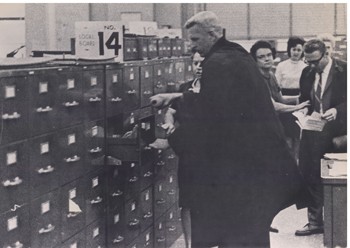US Custom House, Baltimore
Introduction
Text-to-speech Audio
Images
Baltimore Custom House
_-_22.jpg)
Phillip Berrigan During Custom House Action

Backstory and Context
Text-to-speech Audio
Tom Lewis, a local artist and social justice activist was introduced to Philip Berrigan by a mutual friend. As the anti-war movement heated up, they sought new ways to protest the war and get those protests noticed. In 1965, draft card burning had become a popular move (popular enough that Congress made it a felony). However, both Lewis and Berrigan had already each served in the armed services (Berrigan fought in the army in WWII, Lewis was in the National Guard), so burning their own draft cards would have had no meaning. They came to realize that destroying the draft cards of others could serve twofold, as act of civil disobedience, and also as a way of interfering with the bureaucracy of the Selective Service.
They brainstormed and planned with other Baltimore anti-war activists, and two of those, David Eberhardt, who was secretary of the Interfaith Peace Mission, and James Mengel, a minister in the United Church of Christ, decided to join them in their action.
The men were unable to draw enough of their own blood for their purposes, so they had to purchase and mix in animal blood to have sufficient quantities. They entered the offices, distracted the clerks, opened the filing cabinets where the draft records were kept, and managed to anoint approximately 600 draft files with the blood. They then waited to be arrested.
Sources
Cyzyk, Skizz, et al. Hit & Stay. Haricot Vert Films, 2013.
Peters, Shawn Francis. The Catonsville Nine: A Story of Faith and Resistance in the Vietnam Era. New York: Oxford University Press, 2012.
U.S. Custom House, Baltimore, U.S. General Services Administration. Accessed November 1st 2020. https://www.gsa.gov/historic-buildings/us-custom-house-baltimore-md.
Vera de Kok, CC BY-SA 3.0 <https://creativecommons.org/licenses/by-sa/3.0>, via Wikimedia Commons
http://www.jonahhouse.org/archive/pics67-73.htm
